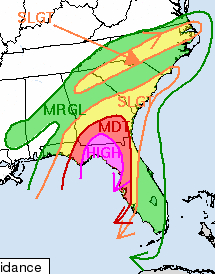
Hurricane Hermine made landfall just east of St Marks near Tallahassee Florida on September 2, 2016. Maximum sustained winds were near 80 mph, which would make it a Category 1 Huuricane. Hermine brought devestating winds to the Big Bend of Florida area which resulted in extensive downed trees and power lines causing significant power outages lasting for days. Hurricane Wilma was the last hurricane to hit Florida, which was in 2005.
Hurricane Hermine Damage in Florida
Insured losses to property damage in Florida by Hurricane Hermine reached US$80 million with 14,890 claims. Preliminary assessments indicated hurricane related damage in excess of US$300 million. Ahead of the hurricane’s landfall, a station south of Apalachicola reported wind gusts of 79 mph (127 km/h) at an elevation of 115 ft (35 m). At sea level, sustained winds reached 52 mph (84 km/h) at Keaton Beach, with gusts 67 mph (108 km/h). While moving ashore, Hurricane Hermine produced a 5.8 ft (1.8 m) storm surge at Cedar Key. Heavy rainfall occurred across western Florida, reaching 22.36 in (568 mm) over 72 hours at the Lake Tarpon Canal in Pinellas County. The outer rainbands of Hurricane Hermine spawned an EF0 tornado just southwest of Windermere with a width of 450 ft (140 m) and 80 to 85 mph (129 to 137 km/h) winds. On the ground for 1.2 mi (1.9 km), the twister damaged about 100 trees, along with several fences and windows.
High winds from the hurricane knocked down many trees in northwestern Florida, some of which fell onto power lines and roofs. The resulting power outages affected about 325,000 people, affecting 1% of all homes and businesses in the state. In Leon County, where the state capital Tallahassee is, 57% of homes lost power, including approximately 80% of the city proper, as well as Florida State University. Strong winds in the Tallahassee area caused trees to fall onto several houses, injuring a number of people. Hermine was the first hurricane to affect the city since Hurricane Kate in 1985.
